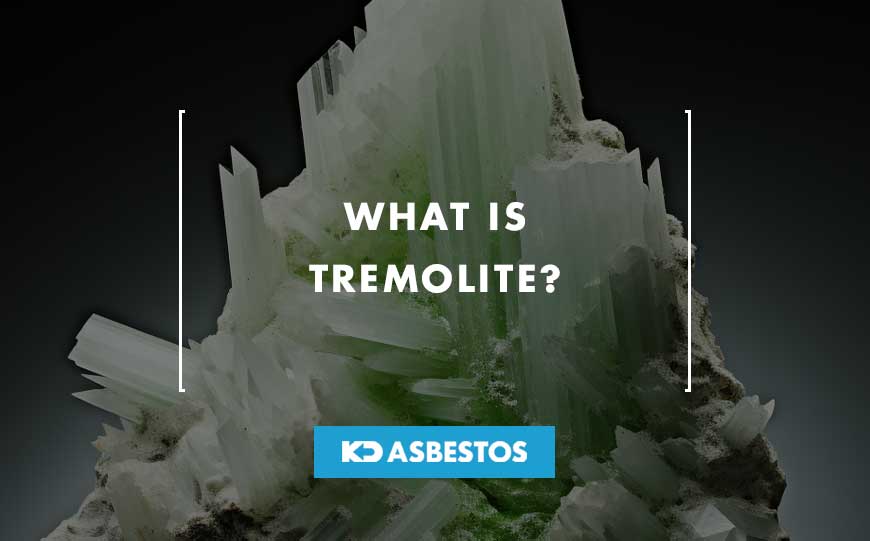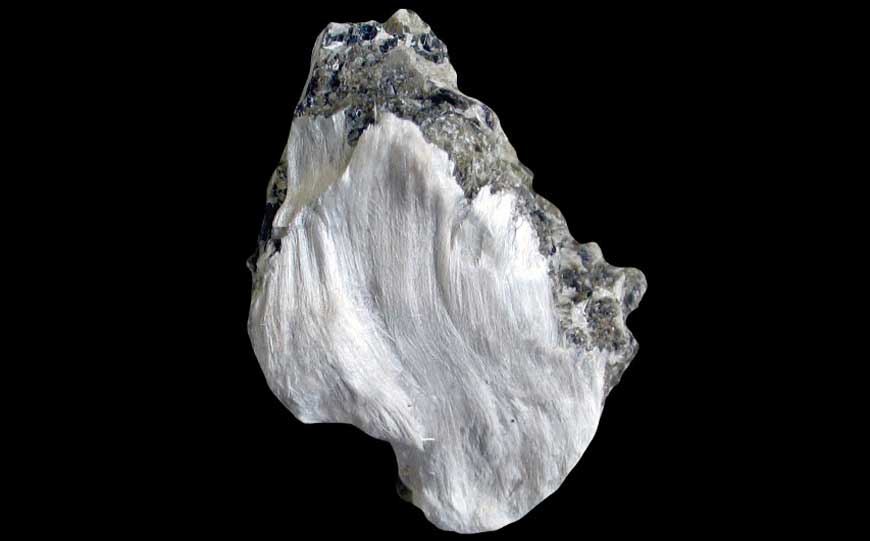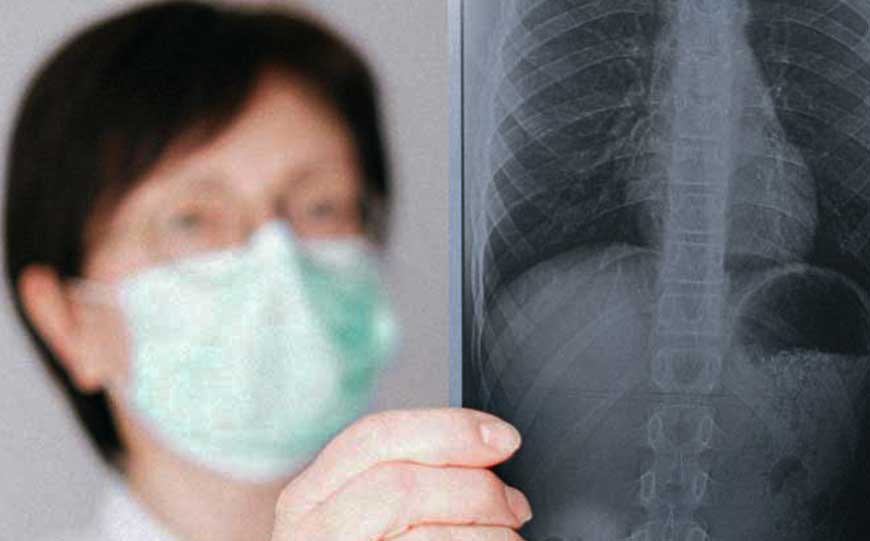
When discussing unusual minerals, tremolite stands as a curious and sometimes concerning presence.
This naturally occurring mineral, belonging to the amphibole group, has unique characteristics that make it both intriguing and, in certain contexts, potentially hazardous.
This article is about everything tremolite – its nature, appearance, historical uses, geographic presence, and the concerns it raises.
Table of Contents
What is Tremolite?
Tremolite is a mineral that belongs to the amphibole group, a category of silicate minerals with compositions encompassing iron, magnesium, calcium, and various other elements.
Specifically classified as a double-chain inosilicate, tremolite has a crystalline structure, commonly forming elongated and slender prismatic crystals.
Its chemical formula is:
Ca2(Mg5.0-4.5Fe2+0.0-0.5)Si8O22(OH)2
Its composition is made up of a combination of calcium, magnesium, iron, silicon, and oxygen.
Found in metamorphic rocks, tremolite emerges under specific geological conditions, especially those involving high pressure and low temperatures.
It is commonly associated with other minerals like diopside, wollastonite, and talc in metamorphic formations.
It was one of the many types of asbestos.
What does Tremolite Look like?

Tremolite can present in various colours, including white, green, grey, or even brown.
Its crystals are often elongated and thin, resembling needles or fibres.
What was Tremolite Used For?
Tremolite, was historically prized for its unique properties that rendered it versatile in various industrial applications.
Here’s examples of its uses and contributions:
Construction Materials
Tremolite asbestos, appreciated for its heat resistance and durability, was commonly incorporated into construction materials.
Asbestos-cement sheets, tiles, and pipes were prevalent in the construction industry.
The addition of tremolite asbestos enhanced the structural integrity and fire resistance of these materials.
Insulation
Due to its excellent insulating properties, tremolite asbestos was a preferred choice for insulation materials.
It was extensively used in building insulation, including in walls, ceilings, and attics.
Its fibrous nature made it effective at trapping air, providing thermal insulation.
Automotive Industry
The automotive industry utilised tremolite asbestos in vehicle components, particularly in brake linings and clutch facings.
The heat-resistant nature of tremolite made it ideal for withstanding the friction and heat generated in these applications, contributing to the efficiency and safety of automobiles.
Textiles
Tremolite asbestos fibres were woven into textiles to create fire-resistant fabrics.
Firefighters’ clothing, industrial aprons, and other protective gear often contained tremolite asbestos to provide a layer of defence against heat and flames.
Electrical Applications
The electrical industry also embraced tremolite asbestos.
It was employed in insulating materials for electrical wiring and equipment.
Its resistance to heat and electricity made it a suitable choice for ensuring safety and preventing electrical fires.
Where is Tremolite Found?
Tremolite is found in metamorphic rocks, particularly those subjected to high-pressure, low-temperature conditions.
It commonly occurs alongside other minerals like diopside, wollastonite, and talc.
Notable deposits are found in regions with metamorphic geology, including India, Italy, Canada, the United States, and China.
How to Identify Tremolite Asbestos
Identifying tremolite asbestos is imperative for safeguarding individuals from potential health hazards associated with asbestos exposure.
While tremolite shares characteristics with other asbestos minerals, its distinct features can aid in identification:
Visual Inspection
Tremolite asbestos is often found in its fibrous form, appearing as thin, needle-like crystals. Its colour can vary, commonly presenting in white, green, grey, or brown hues.
In its natural state, tremolite might resemble other non-asbestos minerals, emphasising the importance of microscopic analysis for accurate identification.
Microscopic Analysis
To definitively identify tremolite asbestos, microscopic examination is essential.
Asbestos fibres are characterised by their long, thin, and fibrous structure.
Polarised light microscopy (PLM) and transmission electron microscopy (TEM) are widely employed techniques to analyse samples for asbestos content.
Refractive Index
The refractive index of tremolite is a key characteristic.
By examining how light passes through a mineral, specialists can determine its refractive index, aiding in differentiation from other minerals.
Environmental Sampling
In settings where asbestos is suspected, environmental sampling can be conducted.
This involves collecting samples from air, soil, or building materials for laboratory analysis.
This process is especially crucial during renovations or demolitions of structures that might contain asbestos.
Professional Assessment
Given the potential health risks associated with asbestos exposure, it is advisable to seek professional assistance for identification.
Asbestos abatement professionals, such as an asbestos surveyor, and industrial hygienists possess the expertise and tools required to accurately identify tremolite asbestos.
KD Asbestos can help with identifying Tremolite asbestos.
Asbestos Testing Kits

While not as comprehensive as professional testing, at-home asbestos testing kits are available.
These kits typically involve collecting a sample and sending it to a laboratory for analysis.
However, their accuracy may vary, and results should be interpreted cautiously.
Historical Documentation
Examining historical records and building documentation can provide insights into the potential presence of asbestos-containing materials, including tremolite.
Older structures, especially those built before asbestos regulations, are more likely to contain asbestos.
What are the Dangers of Tremolite?
Tremolite poses significant health risks due to its fibrous nature and the potential for asbestos exposure.
Any exposure to asbestos is dangerous.
Here’s an exploration of the dangers associated with tremolite:
Asbestos-Related Diseases

Tremolite, and all asbestos fibres, can lead to severe health issues, primarily due to its asbestos content.
Asbestos exposure has been linked to diseases such as asbestosis, lung cancer, and mesothelioma.
These diseases often have long latency periods, with symptoms appearing decades after initial exposure.
Asbestosis
Asbestosis is a chronic lung condition caused by the inhalation of asbestos fibres, including those from tremolite.
The fibres, once lodged in the lungs, cause inflammation and scarring, leading to breathing difficulties.
Asbestosis is irreversible and can progress even after the cessation of exposure.
Lung Cancer
Exposure to tremolite asbestos increases the risk of developing lung cancer.
The fibres, when inhaled, can cause genetic mutations and damage lung tissues.
The risk is further amplified in individuals who smoke, creating a synergistic effect that significantly raises the likelihood of lung cancer.
Mesothelioma
Mesothelioma is a rare and aggressive cancer that primarily affects the lining of the lungs, abdomen, or heart.
Tremolite asbestos exposure is a well-established cause of mesothelioma, and individuals with occupational or environmental exposure are at heightened risk.
Environmental Exposure
Beyond occupational settings, tremolite asbestos can pose risks through environmental exposure.
Natural deposits of tremolite can be disturbed through mining, construction, or natural erosion, releasing asbestos fibres into the air.
Communities living in proximity to such activities may face health risks.
Secondary Exposure
Secondary exposure occurs when individuals come into contact with asbestos fibres brought home by someone working in an asbestos-contaminated environment.
This can put family members, especially children, at risk of asbestos-related diseases.
Lack of Safe Exposure Levels
Unlike some substances with established safe exposure limits, asbestos, including tremolite, does not have a threshold below which exposure is considered safe.
Even minimal exposure to asbestos fibres can contribute to the development of asbestos-related diseases.
Conclusion
Tremolite, a mineral with a complex identity, unveils its secrets through its geological occurrences, historical uses, and potential health risks.
Understanding the nuances of tremolite becomes not only an exploration of Earth’s composition but also an awareness of the challenges it poses in certain contexts.
If you do find or suspect Tremolite, or other asbestos related substances, and require their removal get in touch with us here at KD Asbestos.